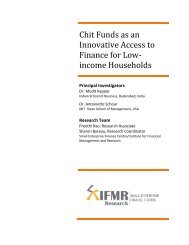Government of India Volume I: Analysis and Recommendations
Government of India Volume I: Analysis and Recommendations
Government of India Volume I: Analysis and Recommendations
Create successful ePaper yourself
Turn your PDF publications into a flip-book with our unique Google optimized e-Paper software.
Contracts, trading <strong>and</strong> market abuse<br />
EXECUTIVE SUMMARY<br />
The last component <strong>of</strong> financial law is the set <strong>of</strong> adaptations <strong>of</strong> conventional commercial<br />
law on questions <strong>of</strong> contracting <strong>and</strong> property rights that is required in fields such as<br />
securities <strong>and</strong> insurance. Statutes as well as case laws have shaped the rules regarding<br />
creation <strong>of</strong> financial contracts, transfer <strong>of</strong> rights, title or interest in such contracts <strong>and</strong><br />
enforcement <strong>of</strong> such rights. These developments have largely been sector specific.<br />
The framework <strong>of</strong> the securities markets requires legal foundations for the issuance<br />
<strong>and</strong> trading <strong>of</strong> securities. Issuance <strong>of</strong> securities requires three kinds <strong>of</strong> restrictions. At<br />
the time <strong>of</strong> the issue, adequate information must be available for an investor to make an<br />
informed decision about valuation. Once the trading commences, a continuous flow <strong>of</strong><br />
information must be available through which the investor can make informed decisions.<br />
Finally, a set <strong>of</strong> rules must be in place through which all holders <strong>of</strong> a given class <strong>of</strong> securities<br />
obtain the identical pay<strong>of</strong>fs. These three objectives would be achieved through<br />
regulations.<br />
Financial markets feature a important role for Infrastructure Institution. The rules<br />
made by these organisations shape the design <strong>of</strong> financial markets to a substantial extent.<br />
The draft Code constrains the behaviour <strong>of</strong> Infrastructure Institutions in three respects:<br />
1. Infrastructure Institutions are required to issue bye-laws <strong>and</strong> abide by them;<br />
2. The objectives that these bye-laws must pursue are defined in the law;<br />
3. They are required to obtain approval from the regulator for bye-laws.<br />
The information about prices <strong>and</strong> liquidity that is produced by financial markets has<br />
a public goods character. The draft Code has provisions that require dissemination <strong>of</strong> this<br />
information. In addition, the falsification <strong>of</strong> this information is termed ‘market abuse’. The<br />
draft Code defines market abuse <strong>and</strong> establishes the framework for enforcement against<br />
it.<br />
Financial regulatory architecture<br />
We now turn to the financial regulatory architecture, or the division <strong>of</strong> the overall work <strong>of</strong><br />
financial regulation across a set <strong>of</strong> regulatory agencies. Many alternative structures can<br />
be envisioned for the financial regulatory architecture. Parliament must evaluate alternative<br />
block diagrams through which a suitable group <strong>of</strong> statutory agencies is h<strong>and</strong>ed<br />
out the work associated with the laws. These decisions could conceivably change over<br />
the years.<br />
At present, <strong>India</strong>n law features tight connections between a particular agency (e.g.<br />
Securities <strong>and</strong> Exchange Board <strong>of</strong> <strong>India</strong> (SEBI)) <strong>and</strong> the functions that it performs (e.g.<br />
securities regulation). The draft Code does not have such integration. Changes in the<br />
work allocation should not require changes to the underlying laws themselves. From<br />
the outset, <strong>and</strong> over coming decades, decisions about the legal framework governing<br />
finance would proceed separately from decisions about the financial regulatory architecture.<br />
This would yield greater legal certainty, while facilitating rational choices about financial<br />
regulatory architecture motivated by considerations in public administration <strong>and</strong><br />
public economics.<br />
At present, <strong>India</strong> has a legacy financial regulatory architecture. The present work<br />
allocation, between RBI, SEBI, Insurance Regulatory <strong>and</strong> Development Authority (IRDA),<br />
Pension Fund Regulatory <strong>and</strong> Development Authority (PFRDA) <strong>and</strong> Forward Markets Commission<br />
(FMC), was not designed. It evolved over the years, with a sequence <strong>of</strong> piecemeal<br />
decisions responding to immediate pressures from time to time.<br />
The present arrangement has gaps where no regulator is in charge – such as the diverse<br />
kinds <strong>of</strong> ponzi schemes which periodically surface in <strong>India</strong>, which are regulated by<br />
xxiv FINANCIAL SECTOR LEGISLATIVE REFORMS COMMISSION



